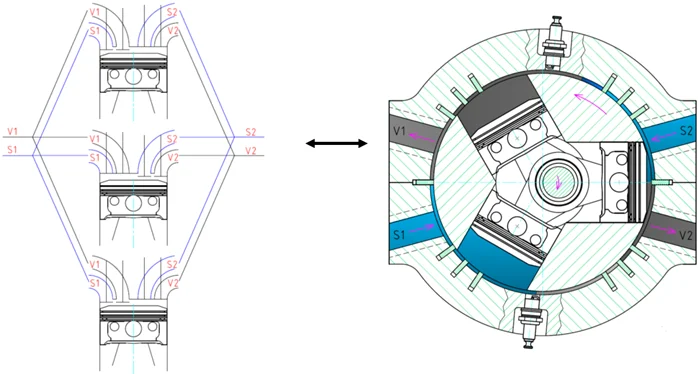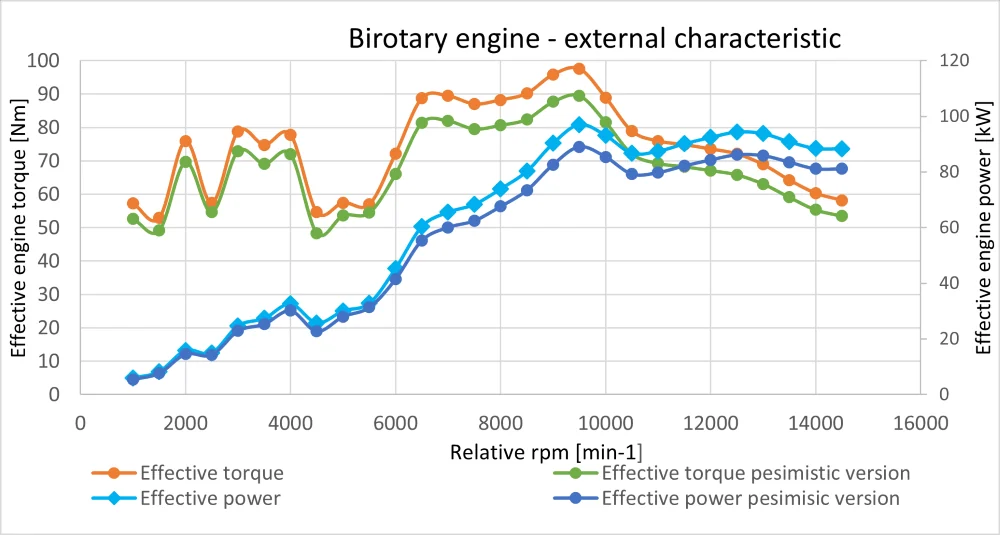Birotary Engine simulations were performed using GT-SUITE software. Two versions of the engine were simulated, a variant with narrow valve timing parameters, designed for aircraft application and a variant with wide valve timing parameters designed to maximize the gain of potential of the engine.
The mathematical simulation of the Birotary engine cycle involved the evaluation of its thermodynamic function. More specifically, the prediction of performance parameters based on a one dimensional solution of gas dynamics resulting in achievable flows and heat transfers in the simulated engine.

Simulation Model Principle
For the thermodynamic simulation, there is no need to resolve the birotary engine kinematics, when the cylinder block rotates in a fixed housing and the crankshaft rotates in the opposite direction. This mechanism can also be imagined as a stationary (stopped) engine cylinder block and an engine housing with ports rotating around the cylinder block. The relative movement of the cylinder bore with respect to the exhaust and intake ports is important for the simulation. This movement together with the shape of the ports defines a curve of port flow area depending on the crankshaft angle of the classic four-stroke cycle. This curve is imposed by means of virtual valves in the simulations. In this way, for simulation purposes, it is possible to convert the birotary engine cycle, which seems to be complicated, to a conventional four-stroke cycle internal combustion engine cycle.
In this case, the only difference from a classic four-stroke engine is the fact that each cylinder uses different ports every second cycle for the intake and exhaust depending on the actual position of the cylinder in the housing. To capture this phenomenon in the simulation, each cylinder is provided with four valves, each of which opens into a corresponding manifold, and a control is created to deactivate and activate the individual valve pairs according to the birotary engine kinematics. This ensures that the gas dynamics in the engine exhaust and intake system correspond to its actual function. Figure below is a diagram of the ports arrangement in the simulation model that is equivalent to the actual engine. In this approach, a pipeline that is branched from one to three is required. This portion of manifold is only used because of the replacement of the cylinder block rotation and therefore the flow between the individual pipe branches is avoided, and the losses in these branches are set to zero.

The flow characteristics of the individual ports depending on the rotation of the engine block are an important input to the simulation. These characteristics were experimentally measured (see above “Flow Parameters”) and then used in the mathematical model, as well as the basic geometry of the engine and the exhaust and intake manifold. The port opening profile was taken from the CAD model and flow coefficients were assigned to this profile.
For the complete calibration of the thermodynamic model, it is advantageous to experimentally measure as much data as possible, such as flow rates, pressures and temperatures at different engine operating points. However, due to the engine development phase, this data could not be provided. Therefore, empirical computational models that are derived from conventional combustion engines were required to be used for the simulation purposes. In some cases, these models are also applicable to the birotary engine – e.g. the model for calculating the heat transfer in the engine cylinder and the burn process. In other areas, due to the specificity of the engine, it is less suitable – including the model for calculating the cylinder wall temperature and the mechanical loss calculation model. Without this data, while it is possible to estimate the engine’s potential in terms of thermodynamics, a degree of uncertainty is to be expected, which could be intensified due to the innovative design of this engine.
Only engine power without any mechanical loss can be precisely predicted. Mechanical losses must be determined experimentally or by more complex calculations. For a rough estimate of the effective engine performance, the Chen-Flynn standard friction loss model constants have been adjusted to the upper limit, which means, it is the most pessimistic estimation available.
Results of the Simulation
The torque and power values, which are above average, can be achieved thanks to the favorable fast opening and closing of the intake and exhaust ports and their large cross sections. This performance is unusual for current conventional poppet valve engines. When the intake and exhaust manifold are properly tuned to the required engine speed, the maximum cylinder filling (region of max. torque) occurs. Outside this optimized area, pressure conditions in the ports are less favorable, excessive internal gas recirculation occurs and torque drops can be observed. This behavior is typical for natural aspirated engines, and probably greatly enhanced by the cross sections and port opening speeds that can be achieved.


The most notable finding is that the value of maximum mean effective pressure is significantly much higher than average results of naturally aspirated spark ignition engines. The graphs for the full load, mean effective pressure and fuel consumption were simulated in two versions. The first version considers common values of computational constants that can influence the accuracy of the calculation. The pessimistic version of the calculation considers less favorable values of the calculation constants, on the upper range for certain models. These two versions define a certain range in which the real engine parameter values can be expected. The results are conditioned by the assumption of sufficient quality of mixture formation, burn rate and efficiency, which are standard for present-day four-stroke cycle engines, and further conditioned by the assumed successful design of all parts that influence the thermodynamic cycle of the engine.

